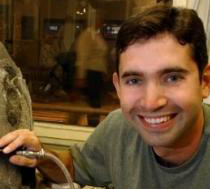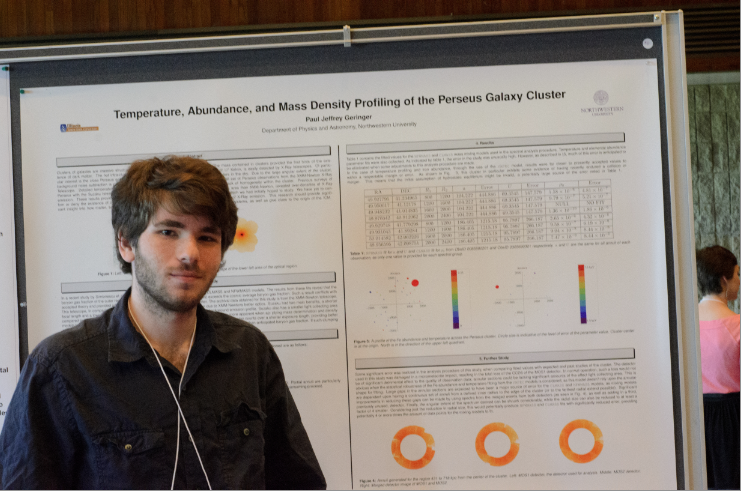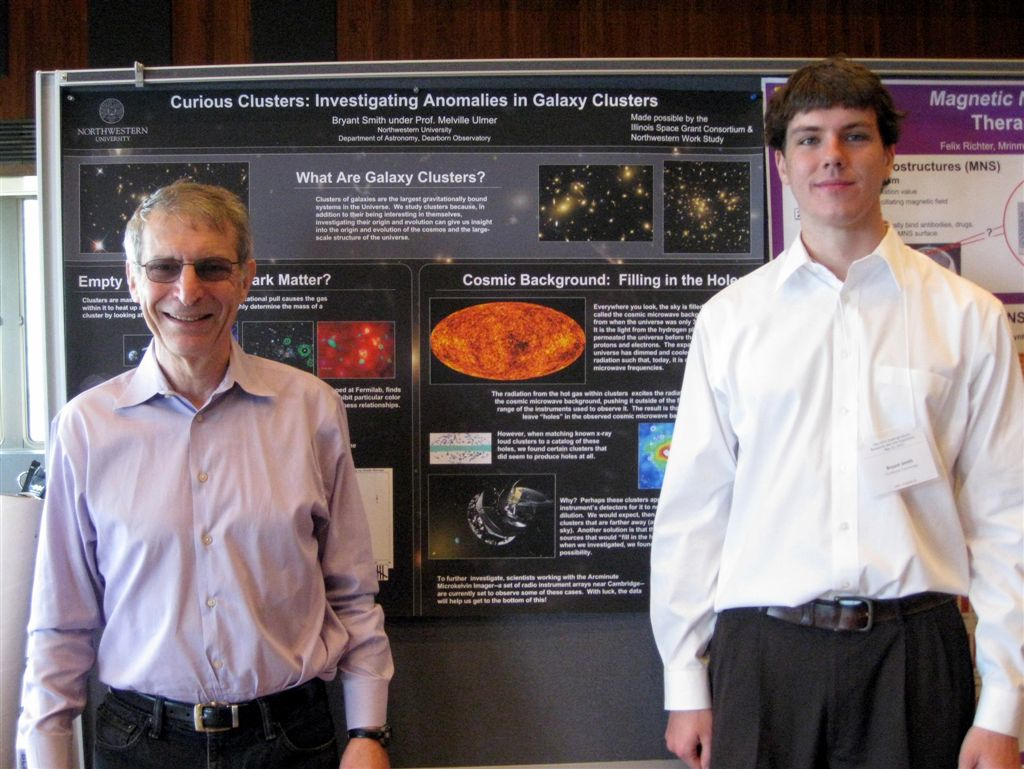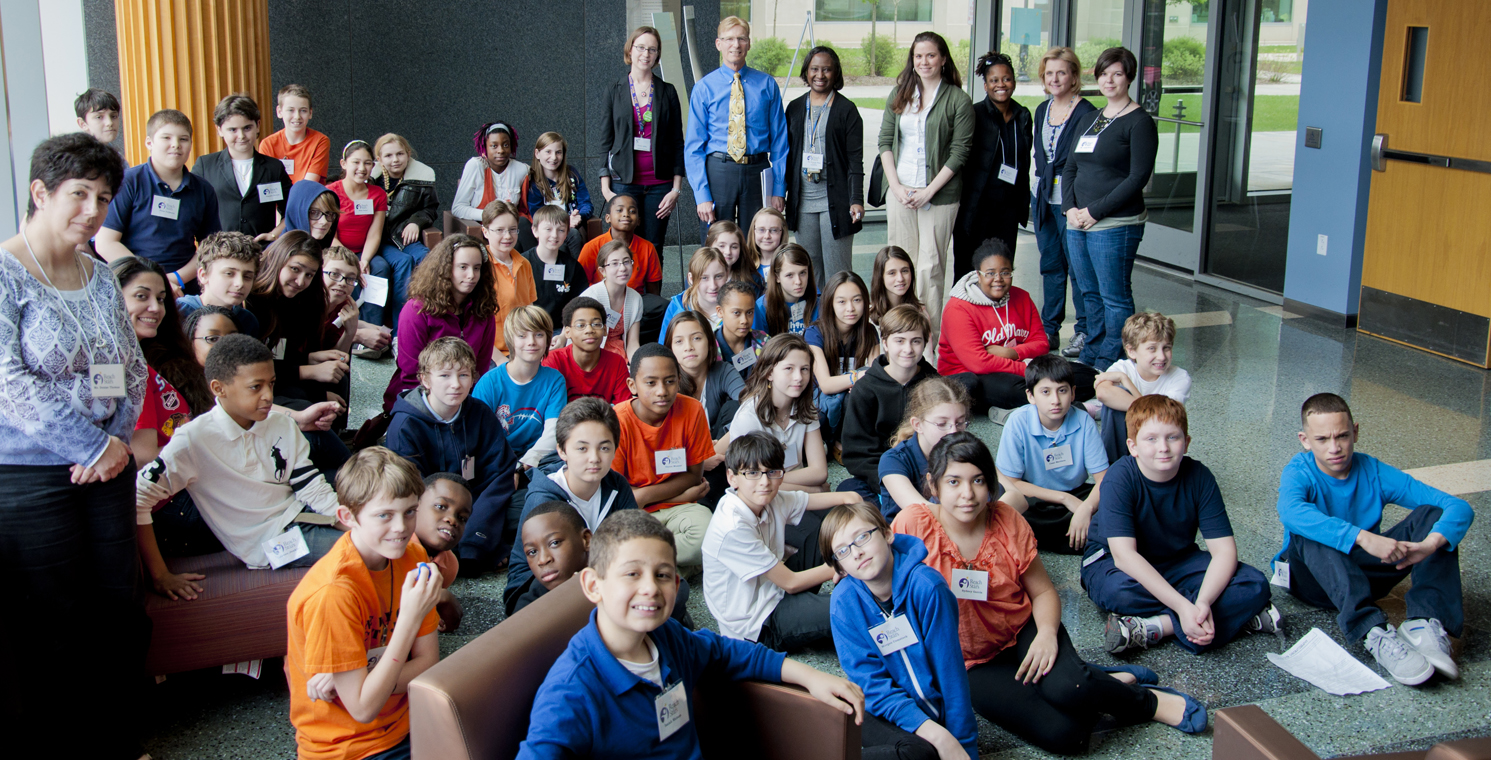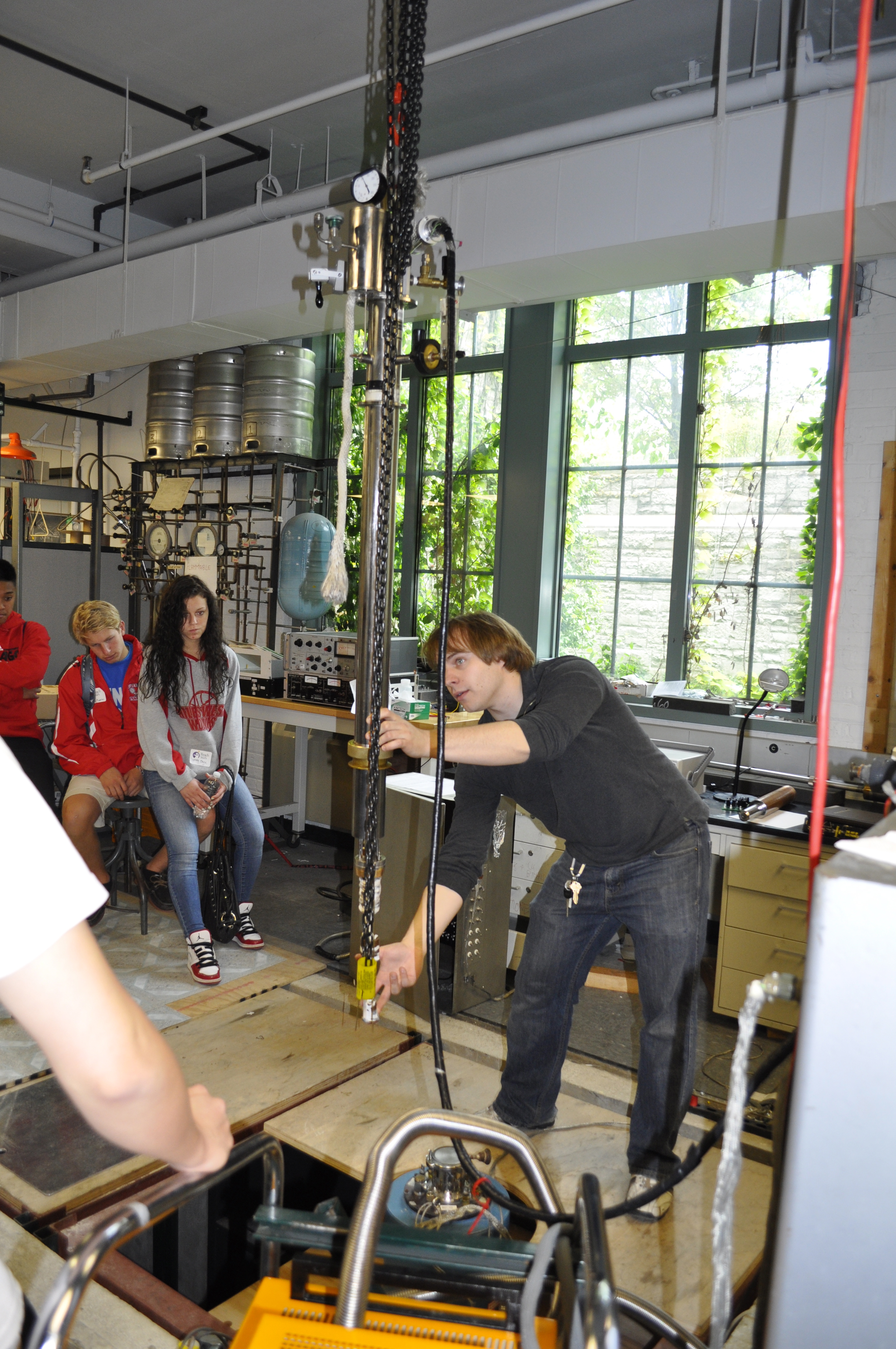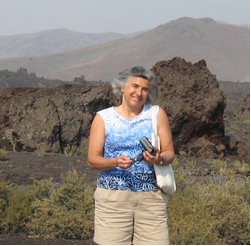AUGUST 2012
|
||||||||||||||||||
 Post-Doc Diego Fazi will apply his expertise to new job in renewable energy
Post-Doc Diego Fazi will apply his expertise to new job in renewable energy
After three years as a CIERA post-doctoral associate, Dr. Diego Fazi will be moving to a new post-doctoral position in the Chemical Sciences and Engineering Division at the Argonne National Laboratory. At CIERA, and as a graduate student, Diego studied gravitational-wave astronomy: he worked with high-performance computers to understand how the motions and collisions of stars can generate waves in the fabric of space and time, via gravity. At Argonne, he will channel his computational and applied math skills into pursuing his passion for renewable energies: Diego will be working on the development of fuels that can be created using solar energy. (One of the most famous examples of this process is using solar power to split water molecules into hydrogen and oxygen, to isolate hydrogen as a fuel.) Of course, if we can make fuels using solar power, those fuels will help us to reduce our dependence on fossil fuels. But, to produce large quantities of these fuels, engineers need specially designed substances called catalysts that help speed the production of the fuel. Diego will be using high-performance computers, and his experience with algorithms developed for gravitational-wave studies, to analyze X-ray measurements of these catalysts and understand their structure. His work on these catalysts will help scientists make progress towards the goal of developing new, abundant, renewable energy sources for the world. | ||||||||||||||||||
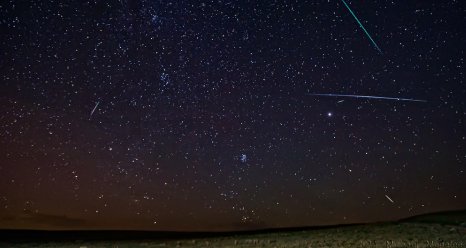 Perseid Meteor Shower Coming to Chicago's Sky!
Perseid Meteor Shower Coming to Chicago's Sky!
Illinois Science Council presents a free educational talk about meteor-watching and meteorites on Thursday, August 9, 2012. Then, for the weekend, Chicago and Evanston Park Districts are extending beach access hours to allow people to sit on the lakefront to look for shooting stars. Take a blanket (and bug spray); sit with family or friends and enjoy a beautiful summer evening while marveling at our planet's place in the galaxy.
Public Perseid Meteor Talk: Thursday, August 9, 2012 | ||||||||||||||||||
| JULY 2012
|
||||||||||||||||||
|
The July 31st, 2012 Astronomy Night at Ravinia was a huge success! The theme this year's event, organized by NU graduate Dr. Donald Lubowich, was "One Score, One Chicago: The Planets". The park hosted many excited astronomy enthusiasts, both young and old, who came to enjoy a great evening with the Chicago Symphony Orchestra and see a show dedicated to the planets in our solar system. Amateurs in astronomy brought their telescopes, set up in formation near the edge of the park. Families and friends arrived, some bringing chairs and tables, others blankets, which created a relaxing picnic environment. It was a memorable evening, with a musical score dedicated to each planet. CIERA, along with Science in Society, Astronomy Magazine, The University of Chicago South Pole Telescope, and Dr. Donald Lubowich from Hofstra University had tables set up in a large tent at the north side of the park. We had several demonstrations available for children to teach them about astronomy. A couple of hours before the concert and throughout the evening, children poured into the tent, eager to learn about the planets! The children were treated to an assortment of props and our team of astrophysics kept them engaged. John Everett, Aaron Geller, Elizabeth Hicks, Kyle Kremer, and Laura Trouille thrilled these kids, and several of them came back a second and even a third time! See pictures of the event on our Astronomy Night at Ravinia 2012 page! | ||||||||||||||||||
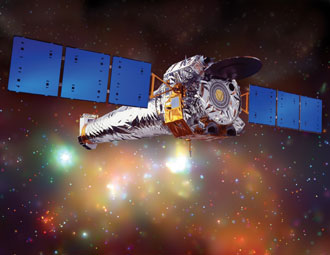 Joint Chandra/XMM/EVLA Monitoring of the Gas Cloud G2 as it Encounters Sgr A*
Joint Chandra/XMM/EVLA Monitoring of the Gas Cloud G2 as it Encounters Sgr A*
Time on space-based telescopes is one of the most important resources for astronomers, and one of the most hotly contested. Competing against many of her peers to use the orbiting Chandra X-ray Observatory, CIERA Postdoctoral Fellow Dr. Daryl Haggard has been granted almost 3.5 days of observing time -- a long time to have a state-of-the-art X-ray telescope to yourself! Daryl leads the Chandra research program with CIERA & Northwestern Prof. Farhad Yusef-Zadeh, Prof. Craig Heinke of the University of Alberta, and Dr. Doug Roberts of the Adler Planetarium & Northwestern University. With the awarded observing time, Daryl and her team will get a unique view of an extraordinary event: the collision of a large cloud of gas with the massive black hole at the center of our Galaxy. In addition to the X-ray data the collaboration was also awarded time on the EVLA and XMM Newton. These observations, and the team's work, will help us understand how black holes grow in the centers of all galaxies. | ||||||||||||||||||
 Variable High Velocity Winds from Broad Absorption Line Quasars
Variable High Velocity Winds from Broad Absorption Line Quasars
You might picture a black hole as some kind of astrophysical "monster," devouring everything in its way. Yet, black holes are rather fussy eaters: they sometimes spit out as much material as they take in. Astronomers still don't understand, in detail, how that ejection process works. In their effort to shed some light on the issue, CIERA Postdoctoral Fellow Dr. Daryl Haggard and NSF-funded graduate student Kenza Arraki (of New Mexico State University) have been awarded funds by the American Astronomical Society to publish their study of gas around massive black holes. By watching the same black holes for six years, they observe the gas being flung away, watch how it changes with time, and so test models of how black holes launch massive "winds." This has important consequences -- when a black hole ejects matter, it tends to grow more slowly, and the gas each black hole ejects has very high velocity. This fast out-flowing gas could disrupt material far from the black hole, perhaps even destroying areas where stars would otherwise be born and changing the face of the host galaxy. | ||||||||||||||||||
 Dr. Daryl Haggard is now officially an editor for the AASWOMEN Newsletter
Dr. Daryl Haggard is now officially an editor for the AASWOMEN Newsletter
Dr. Daryl Haggard is now officially an editor for the AASWOMEN Newsletter. She had guest edited four earlier issues (5/4, 5/18, 6/1, & 6/29). Congratulations Daryl!
The AASWOMEN Newsletter is produced by the American Astronomical Society Committee on the Status of Women. | ||||||||||||||||||
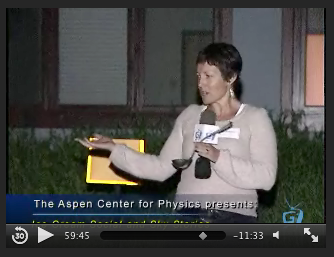 Dr. Daryl Haggard leads Stargazer event, co-hosted by the Aspen Center for Physics
Dr. Daryl Haggard leads Stargazer event, co-hosted by the Aspen Center for Physics
On June 20, 2012, the Aspen Center for Physics (ACP) hosted a Stargazer event which included an Ice Cream Social and Sky Stories. This event was co-hosted by the Aspen Science Center (ASC) and Spellbinders Storytellers.
The Stargazer event was led by Dr. Daryl Haggard (CIERA Postdoctoral Fellow), which included 3 additional astrophysicists. The ACP and ASC staffs pitched in to make it a success. The local Spellbinders organization sent 4 people (including the two founders) to tell star stories. They made really good liquid nitrogen ice cream, which was a big hit with the kids and the adults as well. The crowd of 150 (kids and adults) divided into 4 groups, and teams of two (a Spellbinder and an astrophysicist) circulated from group to group telling stories about the stars and answering questions about stars, galaxies, black holes, etc. There were three telescopes which were focused on Saturn, and lines formed after the stories when it finally got dark. See the event on Aspen Grassroots TV, and the news about the event on the The Aspen Science Center page. | ||||||||||||||||||
Check out the CIERA and Dearborn Observatory facebook pages!
| ||||||||||||||||||
|
||||||||||||||||||
 Congratulations to Carl Rodriguez on receiving honorable mention prize at GWPAW!
Congratulations to Carl Rodriguez on receiving honorable mention prize at GWPAW!
Congratulations to Carl Rodriguez (graduate student-Dept. of Physics and Astronomy) on receiving honorable mention (joint second place) and a 100-euro prize at the GWPAW 2012 meeting! Poster Title: "Inadequacies of the Fisher Matrix in the Advanced Detector Era" Poster Abstract: For several years, the "first-order" approximation of gravitational-wave parameter estimation accuracy has been the Fisher Information Matrix (FIM) due to its ease-of-use and rapid computation time. While the theoretical failings of this method (such as the signal-to-noise ratio (SNR) limit and Gaussian-only posteriors) are well understood, the practical effectiveness compared to a real parameter estimation technique (e.g. Markov-Chain Monte Carlo) remains an open question. We present a direct comparison between the FIM error estimates and the Bayesian probability density functions produced by the parameter estimation code, LALInference. It is determined that, in addition to the SNR limit usually considered, the FIM can substantially overestimate the errors achievable by a well-tuned MCMC search. In some cases, the MCMC search returns errors smaller by several orders of magnitude. We conclude, to no great surprise, that the predictions returned by the FIM do not represent the capabilities of real parameter estimation.
| ||||||||||||||||||
 Dr. Daryl Haggard interviewed on Aspen public television
Dr. Daryl Haggard interviewed on Aspen public televisionClick on image to hear Dr. Haggard's interview Dr. Daryl Haggard (CIERA Postdoctoral Fellow) was interviewed for Aspen public television (GrassRoots Community TV) to promote the Ice Cream Social and Sky Stories at the Aspen Center for Physics, which took place on June 20th. This event was co-hosted by the Aspen Science Center and Spellbinders Storytellers.
| ||||||||||||||||||
John Le awarded Summer Research Grant! John Le (Advisor: Prof. Vicky Kalogera) has been awarded a Weinberg Undergraduate Research Grant in the amount of $3000.00. Congratulations John! This summer he is working with the LIGO and NINJA collaborations to study binary black hole systems. They've found that their spinning and non-spinning models do a good job searching for binary black hole systems when the two black holes are far apart. As this system evolves, the black holes move closer together and their models start to show some inaccuracies. The inaccuracies at the end of their model waveform may cause biases in the parameters recovered by the code because it tries to match these inaccuracies to the data. They have found that the models have a tendency to overestimate the time of coalescence and underestimate the masses. John's project will be to improve the accuracy of their models as time progresses. To achieve this, he will be using numerical relativity results from the NINJA collaborations and run multiple simulations on them with the existing models. These simulations will vary in time and he will have to stop the runs before they reach the end of the signal. However, this will mean that he has less of the wave original wave from the numerical relativity results to use to compare it to. | ||||||||||||||||||
Congratulations to our Seniors Graduating with Honors! This year, four of our graduating seniors have been awarded honors for their outstanding research. Congratulations to all of them for a job well done! Mitchell Drew (Advisor: Prof. Giles Novak),
Paul Geringer (Advisor: Prof. Melville Ulmer),
Kyle Kremer (Advisor: Prof. Vicky Kalogera),
Dan Stevens (Advisor: Prof. Vicky Kalogera & supported by Prof. Sandy Zabell, Statistics and Math Depts.),
| ||||||||||||||||||
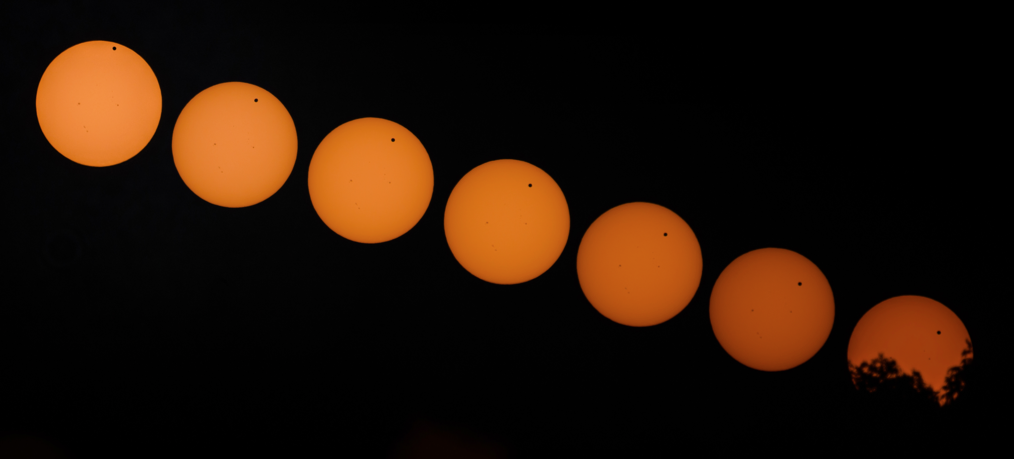 Transit of Venus viewing a huge success! Transit of Venus viewing a huge success!
On Tuesday, June 5th, nearly 1,000 people gathered at Northwestern University in the west courtyard of the Technological Institute and in the Dearborn Observatory to witness a historic astronomical event that won't be repeated for another 115 years. Using a special white light filter, members of the Northwestern community and residents of the local community were able to view the transit of Venus as it journeyed between the Earth and the Sun. Vivien Raymond, Ben Farr, Susan Yu, David Kelley, Paul Geringer, Dan Abramov, Annas Rahman, Laura Kick, Izora Baltys, and Amanda Meyer. It would have been impossible to do this event without all of your help! Read more about this event at the Northwestern Newscenter. See pictures of the event on our Transit of Venus page! Image: Composite of the Transit of Venus, by Dr. Mike Smutko | ||||||||||||||||||
 Get your tickets now: Astronomy Night at Ravinia!
Get your tickets now: Astronomy Night at Ravinia!
Tuesday, July 31st, 2012 8:00 PM Ravinia Pavilion Chicago Symphony Orchestra John Axelrod, Conductor Women of the Chicago Symphony Chorus Gabriela Montero, Piano Reserved $70/$40 Ticket & dining package $75 (Promo code DINING) Lawn $10 Video screen on the Lawn FREE admission (Lawn tickets ONLY) for children under 15 and high school or university students (as long as they have a school ID). You can make the concert a complete evening out when you purchase the concert/dining package for $75 per performance. This convenient package comes complete with dinner in the Mirabelle followed by the performance in Pavilion. Prof. Donald Lubowich, Coordinator of the Astronomy Outreach Program at Hofstra University, will give concertgoers a spectacular glimpse of the heavens. This NASAsponsored program will include observations of the Sun prior to the concert and the Moon, Saturn, Mars, multi-colored double stars, star clusters, and nebulae at intermission and after the concert combined with posters and hands-on-activities. The Adler Planetarium, Chicago Astronomical Society, Northwest Suburban Astronomer, and Skokie Valley Astronomers will assist with this program. The Center for Interdisciplinary Exploration and Research in Astrophysics and Science in Society at Northwestern University and the University of Chicago will be on hand to present exciting demonstrations and activities, and to answer questions about careers in science, celestial objects and events, and the latest astronomical discoveries. For more information and to buy tickets, click HERE! | ||||||||||||||||||
 Dr. Daryl Haggard, CIERA Postdoctoral Fellow, Receives Honorable Mention in L'Oréal Fellowships for Women in Science Program
Dr. Daryl Haggard, CIERA Postdoctoral Fellow, Receives Honorable Mention in L'Oréal Fellowships for Women in Science Program
Each year, L'Oréal awards five fellowships to US-based women postdoctoral researchers to support and promote their advancement in science. The competition for these fellowships is tough: this year, 281 researchers from across science disciplines applied. Standing out among this already strong group, CIERA Fellow Dr. Daryl Haggard advanced to the final round, to which a panel of interdisciplinary scientists admitted only nine applicants. Daryl received an Honorable Mention, and was awarded memberships in the American Association for the Advancement of Science (AAAS) and the Association of Women in Science (AWIS).
Congratulations, Daryl! | ||||||||||||||||||
 See the Transit of Venus Tuesday, June 5th
See the Transit of Venus Tuesday, June 5th
In the late afternoon and evening of June 5th, 2012, Venus will seem to pass across the disk of the sun, an event that won't be visible again from Earth until 2117. You can read more about the Transit HERE. Because the Transit begins late in the afternoon when the sun is already low in the sky, the Dearborn Observatory will NOT be open to the public during this event. However, WEATHER PERMITTING, we will have a telescope setup on the West Courtyard of the Technological Institute (facing Sheridan Road) for passers-by to safely view the Transit from 5:00 pm to sunset (about 8:20 pm). The viewing is open to the public at no charge. | ||||||||||||||||||
MAY 2012 |
||||||||||||||||||
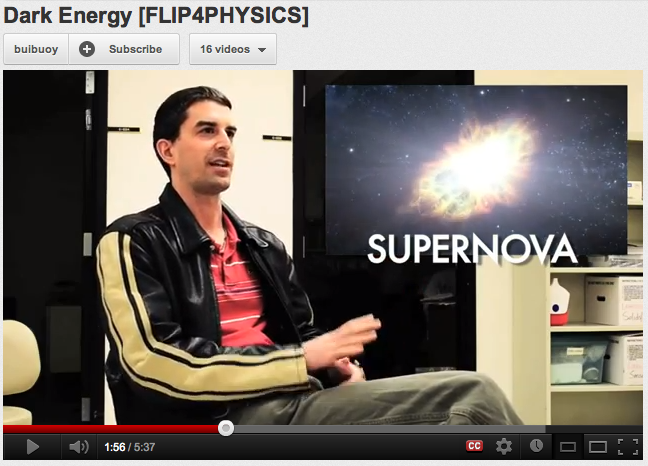 Congratulations to Jordan Shepherd & Darren Bui, from Mattea Valley High School -
Congratulations to Jordan Shepherd & Darren Bui, from Mattea Valley High School -Winners of the 2012 Flip for Physics Mattea Valley High School students Jordan Shepherd & Darren Bui are the winners of the 2012 Flip for Physics contest. They sat down with Dr. Bernstein of the Argonne National Laboratory to talk about what Dark Energy is.
| ||||||||||||||||||
 Alex Ayerdi awarded a Weinberg Undergraduate Summer Research Grant!
Alex Ayerdi awarded a Weinberg Undergraduate Summer Research Grant!
Alex Ayerdi has been awarded a Weinberg Undergraduate Research Grant in the amount of $3000.00. His specific research consists of learning about and implementing the Graphics Processing Unit (GPU) to optimize the processing time of data coming from the Laser Interferometer Gravitational Wave Observatory (LIGO). Normally the Central Processing Unit (CPU) is used to process the data but each individual core can only do a few sets of code at any given time if the programmer is experienced with threading; each thread executes a selection of code. This is a problem because on average, at total CPU capacity, it takes about 1000 CPU hours, or 120 hours in real-time to analyze a set of data. In essence, the CPU has to calculate a function for each set of data in a huge array set (i.e. 400,000 pieces of data to be used by the sin(x) function). The GPU can solve this problem because it is designed to execute a kernel that launches thousands of threads at the hardware level that simultaneously calculate each piece of data in the array and return it back to the user. In theory this should drastically decrease processing time. The challenge is that since the GPU uses smaller individual CPUs, as compared to the larger main CPU, sometimes the main CPU is more useful in an application than the GPU. Therefore, I will be spending much time analyzing the code and determining which parts will be more effectively optimized by the GPU. The project will be using the relatively new CUDA framework to support GPU coding. It has a successful history in other projects that include video game engine performance increase, studying collective behavior of animals, and improving airspace traffic control. Overall, the astrophysicist would like to be less dependent on the processing time of the data so they can test their data against predictions in a reasonable time span. The data that they are analyzing comes from Binary Black Hole mergers, (Prof. Vicky Kalogera's group), and it is used to generate waveforms, of which they analyze and test said predictions. Recent updates to the LIGO observatory is increasing its sensitivity and therefore will make the waveforms even longer. Consequently more data will have to be processed by the CPUs to generate these waveforms and slow down the process even further. This makes the GPU solution even more essential. | ||||||||||||||||||
 Dr. Evghenii Gaburov's Simulations Featured in Keynote Address at Graphics Computing Technology Conference
Dr. Evghenii Gaburov's Simulations Featured in Keynote Address at Graphics Computing Technology Conference
Dr. Evghenii Gaburov, a Hubble Fellow at CIERA until this past May, specialized in developing software for simulating complex astrophysical events, such as gas falling onto black holes. In the process of writing these programs, Evghenii and collaborators at Leiden Observatory worked hard to utilize the power not only of the main processing chip in computers, but also efficient graphics chips available from companies like the NVIDIA Corporation. His work has caught the attention of NVIDIA employees, whose CEO used real-time simulations and visualizations developed by Evghenii and collaborators at Leiden to show the processing power of their newest Graphics Processing Unit (GPU) at the 2012 Graphics Computing Technology Conference. Their work was also featured in two other talks (by Mark Harris, and Stephen Jones & Lars Nyland) at the same conference. The GPU Technology Conference talks are available for view: | ||||||||||||||||||
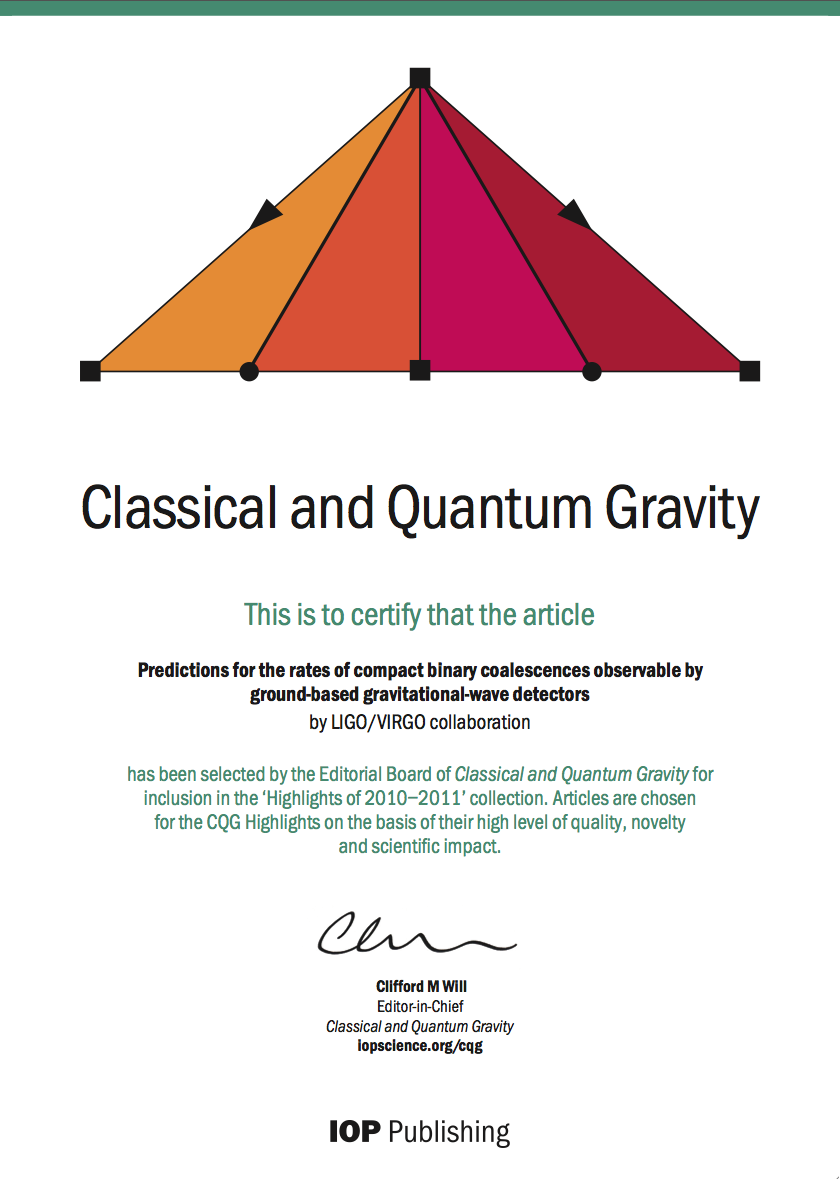 CIERA-led Paper Predicts Collision Rates for Stars, Becomes Most-Cited in its Journal
CIERA-led Paper Predicts Collision Rates for Stars, Becomes Most-Cited in its Journal
Imagine what it would be like to be blind, but then to wake up one day, and be able to see! With a new world in front of you, you would probably be thankful for friends who could help you to understand all of the objects and events you were seeing. Astronomers are about to face a problem very much like this, and Predictions for the Rates of Compact Binary Coalescences Observable by Ground-Based Gravitational-Wave Detectors, written by Dr. Ilya Mandel, Prof. Vicky Kalogera, and colleagues offers this kind of essential help to astronomers. Since being published in 2010, this paper has been so useful that is has become the most highly cited paper in the prominent journal Classical and Quantum Gravity over the past two years, and was the 3rd most-downloaded paper in that journal in 2010, and has also been highlighted by the journal's editors in their own summary of the best papers in 2010-2011. But first, how are astronomers suddenly gaining their sight? Of course, in a lot of ways, the telescopes that astronomers already use allow them extraordinary vision, but most of those telescopes only see light signals that are fundamentally like the light from the Sun. However, amazingly, objects in the universe can send other kinds of signals to us: Einstein realized in 1916 that as black holes and other stars move through space, they distort space, somewhat like a soccer ball hits a net and distorts the net. In a similar way, when black holes pull on each other, especially when two black holes are orbiting each other, they create distortions, or ripples, in the universe that radiate outward in all directions (see the artist's impression above). Those ripples are called "gravitational waves", and those waves offer a new window to the universe; with gravitational waves, we can begin to see objects like black holes, which are extraordinarily hard to see otherwise. Excited at the prospect of this new way of detecting these objects, engineers and astronomers are now working on observatories dedicated to seeing these gravitational waves. They have already built an observatory in the US, called the Laser Interferometer Gravitational Wave Observatory (LIGO) and another in Italy, called VIRGO. One of the most interesting signals that these observatories are looking for is when black holes, orbiting each other, collide, which causes a burst of gravitational waves. The main question the astronomers have, though, is how often that might happen can we actually expect to see the final moments of black holes orbiting each other and colliding? Is such a collision a common event or a rare event? Dr. Mandel (then a CIERA Post-doctoral fellow), Prof. Kalogera, and their colleagues in the LIGO and VIRGO projects wanted to answer exactly that question. Answering this question is crucial not only to understanding data from the LIGO and VIRGO observatories, but is also important because it encapsulates our current understanding of the populations of all kinds of stars that orbit each other, including black holes; if observations show many more or fewer collisions, then this paper will also help us see how much our understanding of those systems needs to change. As we begin to see the universe in a new "light" with gravitational waves, this work will help us understand our observations, and shows the excitement of the field of gravitational-wave astronomy.
| ||||||||||||||||||
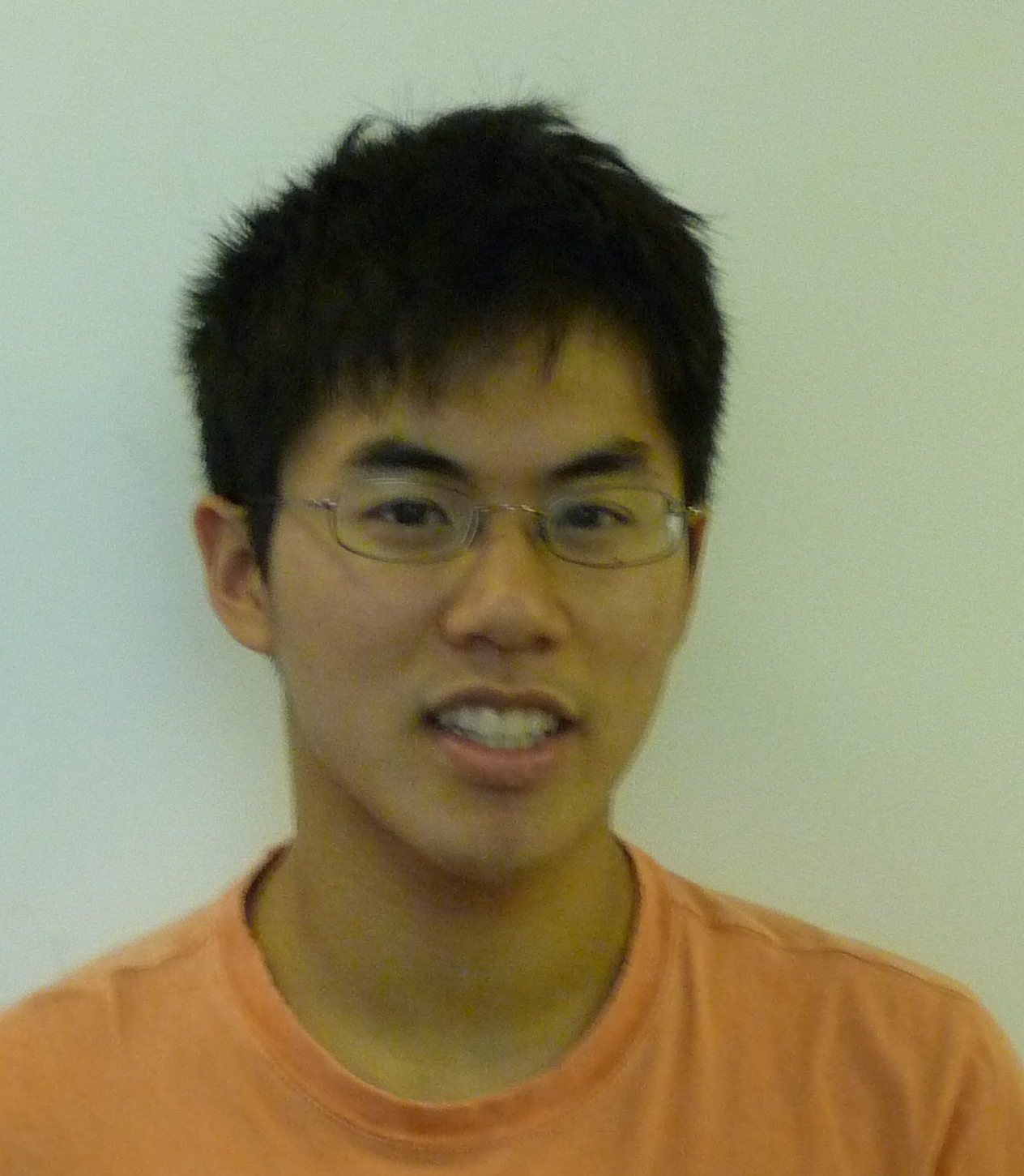 Andrew Srisuwananukorn Wins Krieghbaum Scholarship!
Andrew Srisuwananukorn Wins Krieghbaum Scholarship!
Undergraduate Andrew Srisuwananukorn (Prof. Giles Novak's group) has been awarded a 2012-2013 Katherine L. Krieghbaum scholarship. These scholarships are given to rising seniors by the Weinberg College or Arts and Sciences to "recognize exceptional promise in undergraduate research in the arts and sciences." Andrew will use his scholarship to support a research project titled, "Submillimeter Polarimetry of Saturn's Rings." Read more about the Krieghbaum scholarship, including how to apply, here. | ||||||||||||||||||
 Evanston Township High School-Northwestern University 'Kits n' Cats' Day: Tour of the Dearborn Observatory, May 22nd
Evanston Township High School-Northwestern University 'Kits n' Cats' Day: Tour of the Dearborn Observatory, May 22nd
ETHS-NU 'Kits n' Cats' Day is part of Northwestern University's Community Relations and President Schapiro's Good Neighbor Initiative. On May 22nd, Northwestern University will host around 100 Evanston Township High School students. The students will be greeted by President Schapiro and District 65 Superintendent Eric Witherspoon, have lunch, enjoy a general tour of campus, and also tour academic labs, departments, and special exhibits. This effort is led by Lucile Krasnow, Special Assistant for Community Relations and supported by The Office of STEM Education Partnerships (OSEP) at Northwestern University and Beth Aery, College and Career Coordinator at Evanston Township High School. Kits n' Kats Day would not be possible without the generous time and support given by many Northwestern University faculty, administrators, and staff and their respective departments. These supporters include Prof. Vicky Kalogera and the Center for Interdisciplinary Exploration and Research in Astrophysics (CIERA) and Dearborn Observatory; Undergraduate Admissions, including Rob Walton and Caitlin Smith; and the Northwestern University Materials Research Science and Engineering Center (NU-MRSEC), including Ashley Walters. This will be the second 'Kits n' Cats' Day and will focus on encouraging sophomore students from ETHS to pursue a post-secondary education. Prof. Vicky Kalogera will talk about the Dearborn Observatory and Prof. Mike Smutko will give the students a tour of the Dearborn telescope. | ||||||||||||||||||
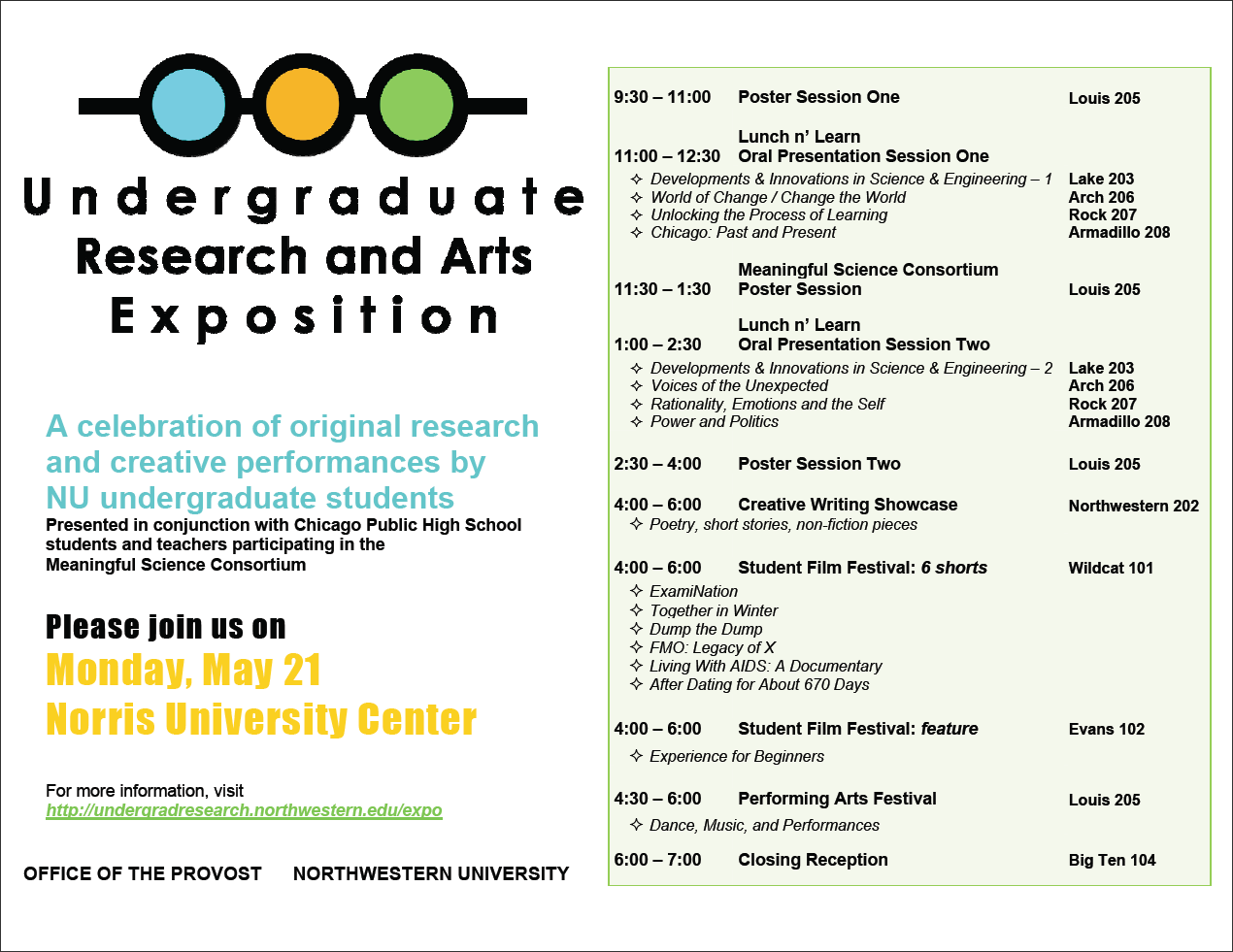 Undergraduate Research and Arts Exposition
Monday, May 21, 2012
Undergraduate Research and Arts Exposition
Monday, May 21, 2012
Norris University Center!<
More information about theUndergraduate Research and Arts Exposition. | ||||||||||||||||||
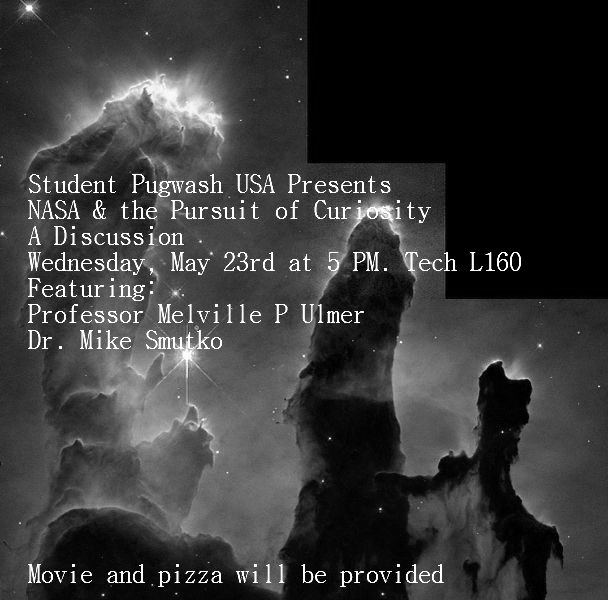 NASA and the Pursuit of Curiosity: A Discussion
NASA and the Pursuit of Curiosity: A Discussion
The Northwestern University chapter of Student Pugwash USA, a student group for the promotion of science discussion and awareness, invites you to a panel discussion: "NASA & the Pursuit of Curiosity: A Discussion" Wednesday, May 23rd 5:00pm Technological Institute (2145 Sheridan Road, Evanston, IL) Room L160 Featuring: Prof. Mel Ulmer and Prof. Mike Smutko Movie and pizza will be provided! | ||||||||||||||||||
 GK-12 Reach for the Stars Graduate Fellows, Kristin Labby and Scott Mayle give a tour of NU Research Facilities to area school kids
GK-12 Reach for the Stars Graduate Fellows, Kristin Labby and Scott Mayle give a tour of NU Research Facilities to area school kids
Reach for the Stars is a GK-12 program funded by The National Science Foundation (NSF). This NSF program places STEM graduate student fellows from Northwestern University in K-12 science classrooms for the entire academic year with the goal of enriching their education and strengthening their development as researchers by advancing their communication and teaching skills. The fellows work in partnership with a collaborating teacher to bring more inquiry-based teaching methods into the classroom and to further expose K-12 teachers and students to the research process. Reach for the Stars is supported by the Center for Interdisciplinary Exploration and Research in Astrophysics (CIERA) and The Office of STEM Education Partnerships (OSEP).
On April 26 and 27 Silverman Hall opened its doors to approximately 100 6th and 7th graders from The Nettelhorst School, a CPS Magnet School and partner on Northwestern University's Reach for the Stars program. While touring Silverman Hall, Nettelhorst students were introduced to medicinal chemistry by Professor Richard B. Silverman and his research group. Kristen Labby, one of Professor Silverman's PhD students, is a Reach for the Stars fellow. Ms. Labby and the Silverman Research Group organized several hands-on labs and demos for the students in both chromatography and the testing of potential medicine molecules. The students were also 'wowed' by the Center for Advanced Molecular Imaging (CAMI), directed by Dr. Thomas Meade, which provides new imaging technologies for researchers. This facility is focused on providing multi-modal analysis of biological systems from the single cell to the whole animal. The students were able to see in 3D the nNOS protein structure that Ms. Labby and the Silverman Group studies! Department of Physics and Astronomy
On April 30 and May 3 the Department of Physics and Astronomy at Northwestern University opened its doors to approximately 50 junior and senior high schools students from Niles West High School. Niles West High School is a partner on Northwestern University's Reach for the Stars program. While touring the Department of Physics and Astronomy, Niles West students visited numerous labs including Prof. Venhat Chandrasekhar's Mesoscopic Physics Group where GK-12 fellow, Scott Mayle, conducts his research. Mr. Mayle has been working at Niles West this academic year with physics teacher, Elizabeth Ramsyer, and this trip was a great opportunity for the students to experience real, authentic research in a university setting. Students also toured Prof. Giles Novak's lab where they learned about electromagnetic fields and the development of astrophysical instrumentation. Dearborn Observatory was a bit hit among the students, as they were able to observe the sun through the telescope. | ||||||||||||||||||
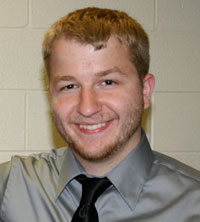 Ben Farr elected Student Representative of the American Physical Society's Topical Group in Gravitation
Ben Farr elected Student Representative of the American Physical Society's Topical Group in Gravitation
Ben Farr, Physics & Astronomy graduate student, an NSF Graduate Fellow, and a member of Prof. Vicky Kalogera's group , has been elected Student Representative for the American Physical Society's Topical Group in Gravitation. The names of all 2012 GGR officers are here. Here is a little more information about the Topical Group in Gravitation. | ||||||||||||||||||
 Dr. Daryl Haggard guest edits the May 4, May 18, and the June 1 editions of the AASWOMEN Newsletter
Dr. Daryl Haggard guest edits the May 4, May 18, and the June 1 editions of the AASWOMEN Newsletter
Dr. Daryl Haggard (CIERA Postdoctoral Fellow), was a guest editor for the May 4th, the May 18th, June 1st, and the June 29th 2012 editions of the AASWOMEN Newsletter. The AASWOMEN Newsletter is produced by the American Astronomical Society Committee on the Status of Women. | ||||||||||||||||||
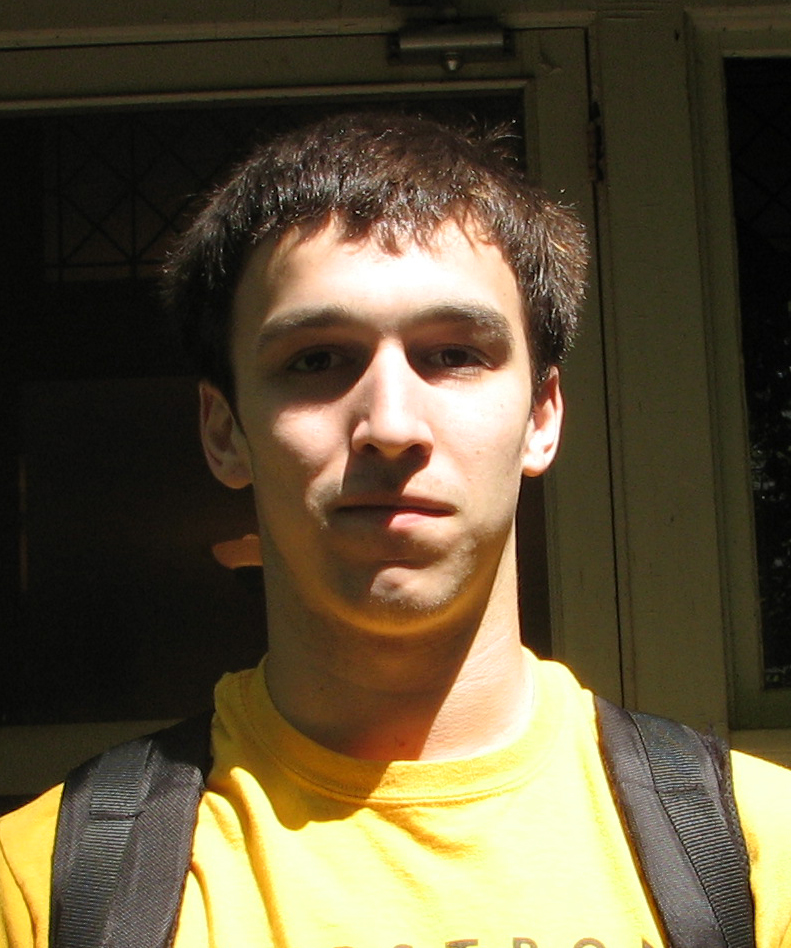 Kevin Broh-Kahn has been awarded a NU Summer URG!
Kevin Broh-Kahn has been awarded a NU Summer URG!
Kevin Broh-Kahn (Computer Science major), has been awarded a Northwestern University Summer Undergraduate Research Grant. Congratulations Kevin! The title of his independent research project is: "Performance and Data Analysis of Parallel Monte Carlo Algorithm for Simulating Dense Stellar Systems". Kevin's faculty advisor for this project is Prof. Vicky Kalogera. | ||||||||||||||||||

We are proud to announce that: The Weinberg College Teaching Awards applaud excellence in instruction, significant contributions to curricular innovation, exemplary mentoring of research and independent study, and fostering of a sense of community both inside and outside the classroom. | ||||||||||||||||||
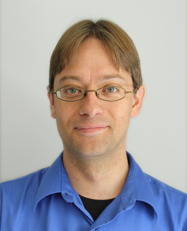 Welcome Dr. John Everett, CIERA's new Assistant Director of Operations!
Welcome Dr. John Everett, CIERA's new Assistant Director of Operations!
We are happy to announce that Dr. John Everett will be joining us as the new CIERA Assistant Director of Operations, beginning May 14th. John is moving to Northwestern from University of Wisconsin-Madison where he has been for the past few years as a postdoctoral associate and, more recently, as an Assistant Scientist at the Center for Magnetic Self-Organization in Laboratory and Astrophysical Plasmas. Earlier he was a CITA postdoctoral fellow and he got his PhD from the U. of Chicago. His research interests are in the area of plasma astrophysics and magnetohydrodynamics. He also has had experience with management and organization of events and has collaborated with researchers from different disciplines. Apart from his management and planning work in close collaboration with Prof. Vicky Kalogera, John will continue to pursue research projects of interest to him in collaboration with current or future CIERA members, students and postdocs. Please join us in welcoming John to CIERA now in spirit and physically when he moves here in less than a month! | ||||||||||||||||||
|
||||||||||||||||||
 Dr. Jason Steffen accepts offer for a CIERA fellowship, beginning in the Fall of 2012.
Dr. Jason Steffen accepts offer for a CIERA fellowship, beginning in the Fall of 2012.
We are pleased to announce that Dr. Jason H. Steffen has accepted our offer for CIERA fellowships, beginning in the Fall of 2012. He works on dynamical studies of planetary systems identified in the Kepler data. Specifically, the gravitational interaction of multiple planets in a single system will cause each planet's orbital period to change slightly from one orbit to the next. These deviations can be used to measure the orbital properties and masses of the planets in the system. Dr. Steffen's research will be in collaboration with Prof. Fred Rasio and Prof. Heidi Schellman. We look forward to welcoming him to CIERA in Fall 2012. | ||||||||||||||||||
Stephanie Tang, CIERA's Research Coordinator for Spring 2012 Ms. Stephanie Tang will be starting in a temporary capacity as our new Research Coordinator, beginning April 16, 2012. Ms. Tang just finished her Bachelor's degree at Northwestern University, majoring in Psychology, Legal Studies, and International Studies in the Winter quarter, 2012. She will be begin her graduate studies this summer at the Loyola University Chicago School of Law. | ||||||||||||||||||
|
||||||||||||||||||
 "Is NASA still relevant?", by Joanna Carver
"Is NASA still relevant?", by Joanna Carver
President Obama has proposed a 20 percent budget cut to NASA's funding for next year, putting a serious strain on big science. The glory days of Alan Shepard and Neil Armstrong were decades ago and NASA now seems to be winding down. So, is NASA still relevant? Prof. Mel Ulmer (Northwestern University), Prof. Don York (University of Illinois Chicago), and Prof. Mike Smutko (Northwestern University) explain why yes, it definitely still is. | ||||||||||||||||||
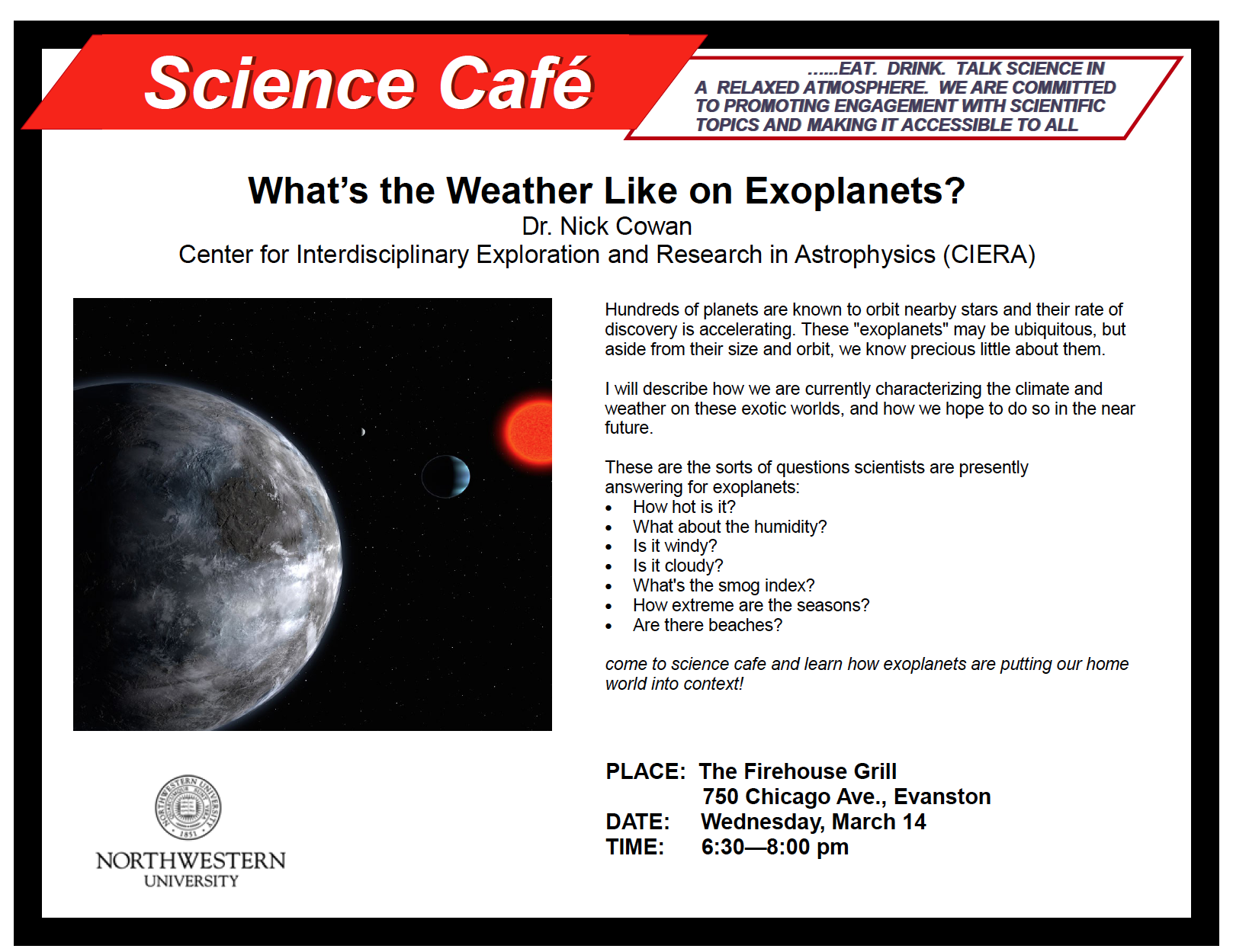 What's the Weather Like on Exoplanets?
What's the Weather Like on Exoplanets?
If you're looking for something to do on Wednesday, March 14 from 6:30-8:00pm, consider swinging by the Firehouse Grill at 750 Chicago Avenue in Evanston to hear the latest and greatest about extrasolar planets, from Dr. Nick Cowan! | ||||||||||||||||||
|
Hell off Earth: Blustery Exoplanet Charted in 2-D for First Time
A mere 60 light-years away, orbiting an orangish star called HD 189733, is a world an Earthling would not want to visit. The planet is a gas giant, like Jupiter or Saturn, but unlike those familiar worlds this one hugs tightly to its host star, orbiting at about one thirtieth the distance at which Earth circles the sun. The exoplanet, labeled HD 189733 b by astronomical convention, stays mighty toasty under its astronomical broiler, with temperatures upward of 900 degrees Celsius. Thanks to a new study, any hypothetical unfortunates forced to visit HD 189733 b will know which part of the planet is the most infernal. Dr. Nicolas Cowan, CIERA postdoctoral fellow at Northwestern University, Prof. Eric Agol from the University of Washington in Seattle (U.W.), and Carl Majeau, undergraduate from Columbia University, have produced a thermal map of the planet's atmosphere in both latitude and longitude. Read more about this story on Scientific American at Yahoo!News. The full publication of this article, A TWO-DIMENSIONAL INFRARED MAP OF THE EXTRASOLAR PLANET HD 189733b, is available on The Astrophysical Journal Letters | ||||||||||||||||||
|
||||||||||||||||||
|
Dr. Nate Kaib and Dr. Junfeng Wang accept offers for a CIERA fellowship, beginning in the Fall of 2012!
We are pleased to announce that Dr. Nate Kaib and Dr. Junfeng Wang have accepted our offers for CIERA fellowships, beginning in the Fall of 2012. Nate will join CIERA following his current position as a CITA National Fellow at Queen's University in Canada. His research focuses on studies of the dynamics of planets and small bodies in planetary systems. Junfeng will move to CIERA from the Harvard-Smithsonian Center for Astrophysics where he has held a Smithsonian Astrophysical Observatory Postdoctoral Fellowship. His research covers a wide range of topics, from massive star-forming regions to circum-nuclear regions of nearby galaxies using NASA's Chandra X-Ray Observatory and accompanying multi-wavelength observations. We look forward to welcoming both of them to CIERA in Fall 2012. | ||||||||||||||||||
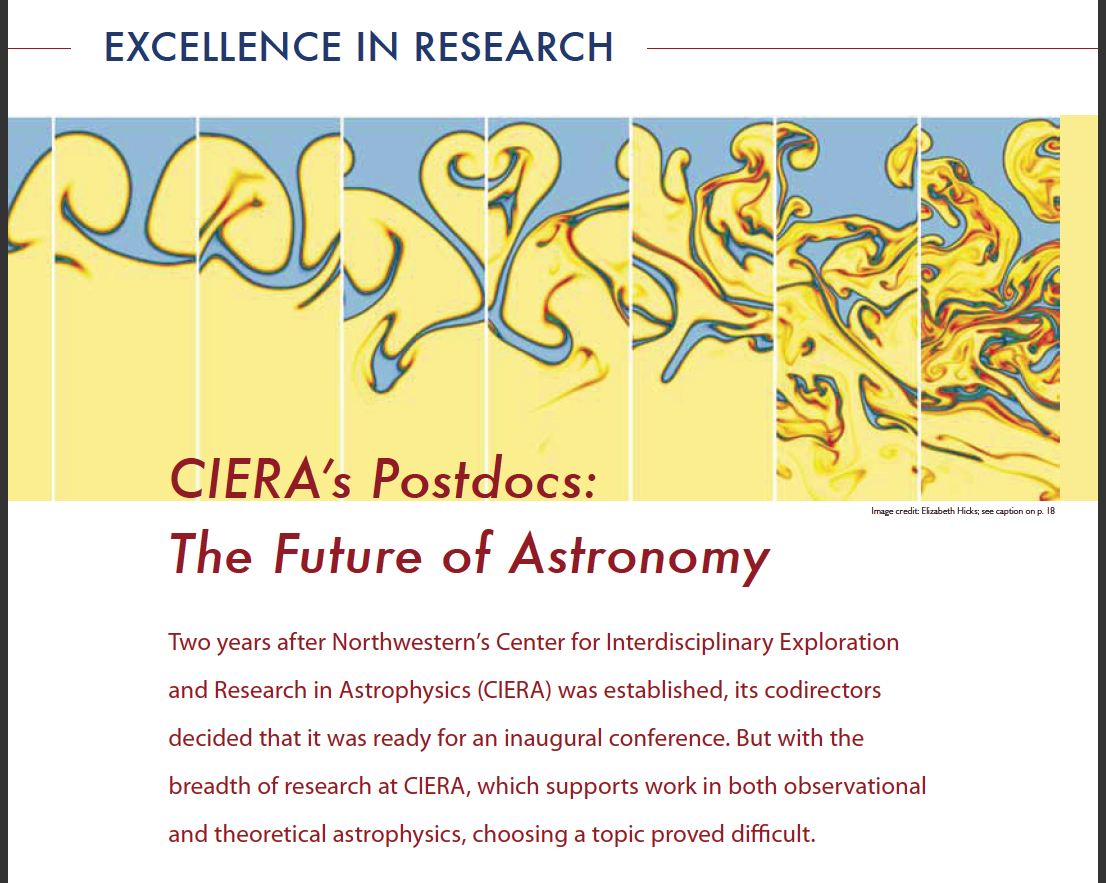 CIERA's Postdocs: The Future of Astronomy
CIERA's Postdocs: The Future of Astronomy
The following article, written by Amanda Morris, is from the Northwestern University Office of Research - Annual Report 2011 Two years after Northwestern's Center for Interdisciplinary Exploration and Research in Astrophyiscs (CIERA) was established, its codirectors decided that it was ready for an inaugural conference. But with the breadth of research at CIERA, which supports work in both observational and theoretical astrophysics, choosing a topic proved difficult. "Other astrophysics centers are not as broad as CIERA," says Vicky Kalogera, physics and astronomy and codirector of CIERA. "They tend to focus on a specific part of astrophysics. So when they organize a conference, it usually focuses on that specific area." After multiple discussions among Kalogera and CIERA codirectors Fred Rasio and Dave Meyer, they decided that the conference should focus on one of CIERA's most prized assets: its postdocs...read more here . | ||||||||||||||||||
Transforming Cultural Norms Dr. Laura Trouille, CIERA Postdoctoral Fellow, wrote an article for the American Astronomical Society (AAS) newsletter on transforming cultural norms in astronomy departments and institutions. The article presents the main topics of discussion from the panel discussion led by the Committee on the Status of Women in Astronomy during the May 2011 Boston AAS conference. The goals of the session were (1) to provide information to the community on how to organize, fund, and ensure the sustainability and institutionalization of mentoring groups and (2) to present examples showing how departments have managed to change the climate so that mentoring and networking groups become accepted as the norm.
Click here for the full article (begins on page 9). | ||||||||||||||||||
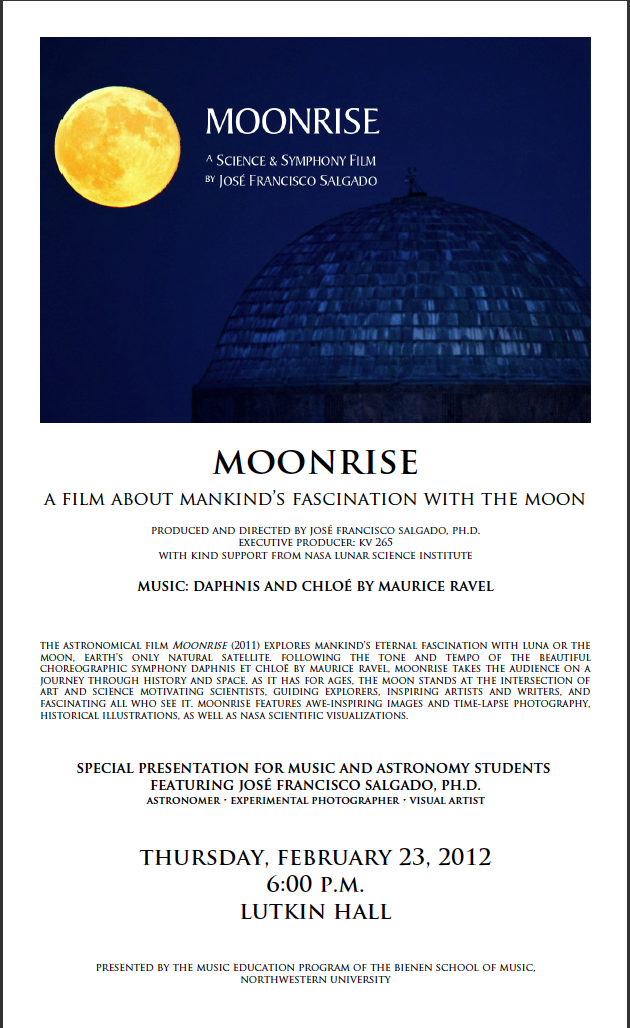 Moonrise: a Film about Mankind's Fascination with the Moon
Moonrise: a Film about Mankind's Fascination with the Moon
Executive Producer: KV 265 with kind support from NASA Lunar Science Institute Music: Daphnis and Chloé by Maurice Ravel The astronomical film Moonrise (2011) explores mankind's eternal fascination with Luna or the Moon, Earth's only natural satellite. Following the tone and tempo of the beautiful choreographic symphony Daphnis et Chloé by Maurice Ravel, Moonrise takes the audience on a journey through history and space. As it has for ages, the moon stands at the intersection of art and science motivating scientists, guiding explorers, inspiring artists and writers, and fascinating all who see it. Moonrise features awe-inspiring images and time-lapse photography, historical illustrations, as well as NASA scientific visualizations. featuring José Francisco Salgado, ph.d. Astronomer Experimental Photographer Visual Artist Thursday, February 23, 2012 6:00 p.m. Lutkin Hall Presented by the Music Education Program of the Bienen School of Music, Northwestern University | ||||||||||||||||||
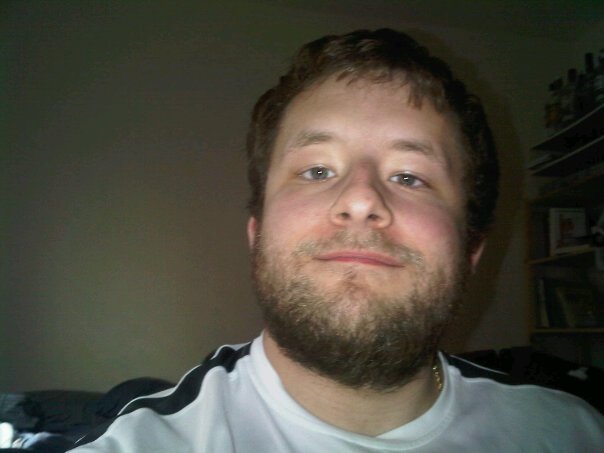 Dan Stevens receives the J. G. Nolan Scholarship for the 2011-2012 academic year
Dan Stevens receives the J. G. Nolan Scholarship for the 2011-2012 academic year
Dan Stevens has been selected to receive the J. G. Nolan Scholarship for the 2011-2012 academic year. The scholarship money is replacing funds from another financial aid grant that NU gave to Dan previously, so it's being applied towards tuition (and the like) for the Winter and Spring Quarter.
| ||||||||||||||||||
 Michael Smutko has accepted a full-time Distinguished Senior Lecturer position in the Department of Physics and Astronomy
Michael Smutko has accepted a full-time Distinguished Senior Lecturer position in the Department of Physics and Astronomy
We are happy to announce that Michael Smutko has accepted a full-time Distinguished Senior Lecturer position in the Department starting this Spring. He will be teaching both physics and astronomy courses. For the past eight years, Michael has held a joint appointment with the Adler Planetarium. We are delighted that the Department will now be able to benefit more fully from his expertise.
| ||||||||||||||||||
 Vivien Raymond accepts offer for the Richard Chase Tolman Postdoctoral Fellowship
Vivien Raymond accepts offer for the Richard Chase Tolman Postdoctoral Fellowship
Graduate student Vivien Raymond accepted an offer for the Richard Chase Tolman Postdoctoral fellowship in Experimental Physics; he will be moving to Caltech following his PhD graduation in Summer 2012. He works in Kalogera's research group on physical parameter estimation of gravitational waves from binary coalescence with spinning compact objects within the LIGO Scientific Collaboration. Congratulations Vivien!
| ||||||||||||||||||
 Picturing and Observing the Night Sky
Picturing and Observing the Night Sky
CIERA and the Block Museum hosted "Picturing and Observing the Night Sky" on Wednesday, Feb. 1 at 7:00pm in the Dearborn Observatory. Block Museum senior curator Debora Wood and Michael Smutko, distinguished senior lecturer in physics and astronomy at the Weinberg College of Arts and Sciences, discussed how early astronomers mapped the stars. Afterwards participants saw the stars through the University's historic telescope.
| ||||||||||||||||||
January 2012 |
||||||||||||||||||
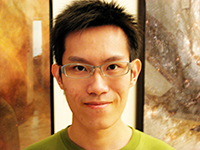 Tsing Wai Wong wins a CIC - Smithsonian Institution Predoctoral Fellowship!
Tsing Wai Wong wins a CIC - Smithsonian Institution Predoctoral Fellowship!
Tsing Wai Wong, a graduate student in the Department of Physics and Astronomy, won a CIC - Smithsonian Institution Predoctoral Fellowship! Tsing Wai is a member of Prof. Vicky Kalogera's research group. | ||||||||||||||||||
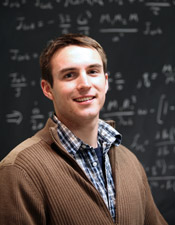 Kyle Kremer wins a Churchill Scholarship for 2012-13!
Kyle Kremer wins a Churchill Scholarship for 2012-13!
Kyle Kremer, a senior double-majoring in Physics and Trumpet Performance (trumpet and flugelhorn), and a Goldwater Scholar and a Robert C. Byrd Scholar, has won the Churchill Scholarship! Kyle conducts research on compact objects in binary systems in Prof. Vicky Kalogera's group. With the Churchill Scholarship, Kyle will be pursuing a Masters of Advanced Study degree in theoretical astrophysics at the University of Cambridge. | ||||||||||||||||||
 Dr. Jill Lynette Hanna Price won the 2010 Women in Aerospace Achievement Award
Dr. Jill Lynette Hanna Price won the 2010 Women in Aerospace Achievement Award
NASA Langley Aerospace Engineer Jill Lynette Hanna Prince, former Undergraduate Research Assistant for Prof. Giles Novak, received the Women in Aerospace Achievement Award award during the Women in Aerospace organization's annual awards ceremony and banquet held at the Ritz-Carlton Hotel in Arlington, VA on October 26, 2010. Four current NASA leaders and one retiree were recognized for their work by Women in Aerospace. The event celebrates women's professional excellence in aerospace and honors women who have made outstanding contributions to the aerospace community. | ||||||||||||||||||
|
||||||||||||||||||
 Ripples in the Universe: Catching Gravitational Waves with LIGO
Ripples in the Universe: Catching Gravitational Waves with LIGO
Carl Rodriguez gave a public talk at Purdue University North Central in Westville, Indiana. The talk, titled "Ripples in the Universe: Catching Gravitational Waves with LIGO", described the current status of the LIGO project, describing the exciting science potential of gravitational wave astronomy. The talk was sponsered by the Local Astronomy Club and attended by students from local elementary schools. In addition to the talk, the presentation included several visualizations to better describe spacetime, which can be found here. | ||||||||||||||||||
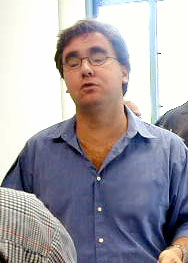 Prof. Frederic A. Rasio appointed as
Prof. Frederic A. Rasio appointed aseditor of The Atrophysical Journal Letters CIERA co-director, Prof. Frederic A. Rasio has been appointed as the next editor of The Astrophysical Journal Letters. The mission of the letters section is to allow "astrophysicists to rapidly publish short notices of significant original research." Rasio will begin serving as editor on January 1st, 2013. Full article from Northwestern News Center here. | ||||||||||||||||||
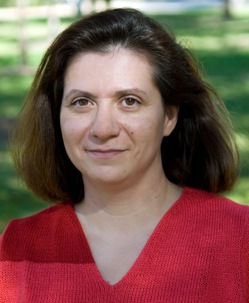 CIERA Co-Director, Prof. Vicky Kalogera, is awarded
CIERA Co-Director, Prof. Vicky Kalogera, is awardeda Simons Foundation Fellowship in Theoretical Physics CIERA co-director, Vicky Kalogera, is awarded a Simons Foundation Fellowship in Theoretical Physics for her research proposal entitled "Decoding Gravitational-Wave Signals from Compact Object Mergers". The Fellowship will support a full-year sabbatical leave away from teaching and service work and will allow her to focus on research initiatives within the interdisciplinary environment fostered by CIERA. Per the Foundation's guidelines "awards are based on the applicant's scientific accomplishment in the five-year period preceding the application and on a judgment of the potential scientific impact of the leave period." The Foundation makes up to 20 awards in all areas of theoretical physics each year. More details here.
| ||||||||||||||||||
Exoplanets: Could there be other habitable worlds out there? CIERA Astronomers (Ben Farr, Diego Fazi, Meagan Morscher, Sara Rastegar, and Vivien Raymond) went to the Roosevelt Elementary School Science Fair on December 2nd, and presented an interactive booth where students and their families could learn about planets outside of our Solar System, known as exoplanets. They were shown how astronomers discover new planets, figure out what they are composed of, and what we think it takes for a planet to be habitable. Could there be other life out there?
| ||||||||||||||||||
 CIERA Supports Outstanding Research with Local High School Students
CIERA Supports Outstanding Research with Local High School Students
This past weekend two Evanston Township High School students, Julia Farenga-Crowley and Patrick Loftus, won third place in the national Siemens Talent Competition. Their essay, poster, and 15 minute presentation on their summer research project with Northwestern University CIERA postdoctoral fellow Dr. Laura Trouille caught the attention of the judges and garnered them each a $20,000 college scholarship. The students were connected with Dr. Trouille through Northwestern's Office of STEM Education Partnerships. Read more about Julia and Patrick HERE on the Siemens-Foundation website. | ||||||||||||||||||
|
||||||||||||||||||
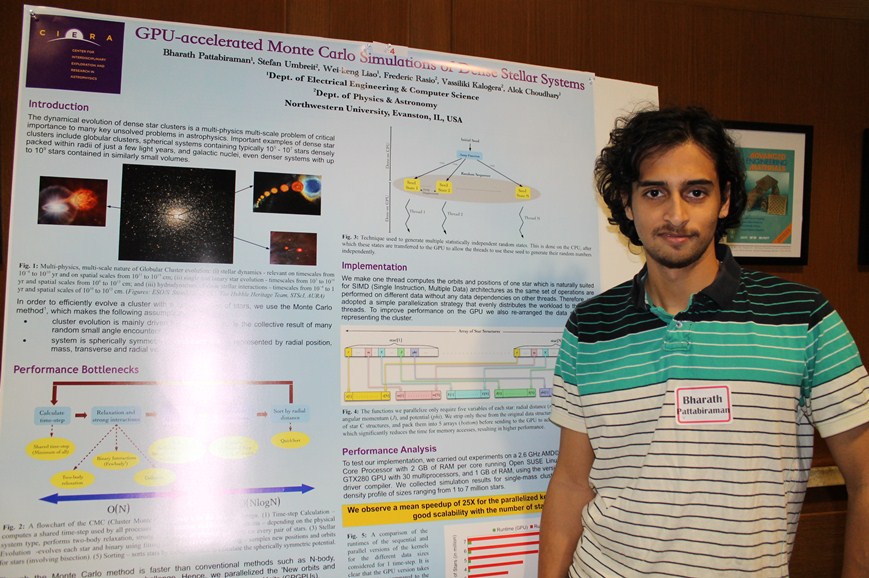 Bharath Pattabiraman was awarded "Best Poster Award" at the "Conference on Computational Physics", held in Gatlinburg, TN
Bharath Pattabiraman was awarded "Best Poster Award" at the "Conference on Computational Physics", held in Gatlinburg, TN
Poster Abstract: Computing the interactions between the stars within dense stellar clusters is a problem of fundamental importance in theoretical astrophysics. However, simulating realistic sized clusters of about 106 stars is computationally intensive and often takes a long time to complete. This paper presents the parallelization of a Monte Carlo method- based algorithm for simulating stellar cluster evolution on programmable Graphics Processing Units (GPUs). The kernels of this algorithm involve numerical methods of root-bisection and von Neumann rejection. Our experiments show that although these kernels exhibit data dependent decision making and unavoidable non-contiguous memory accesses, the GPU can still deliver substantial near-linear speed-ups which cannot be easily achieved on a CPU-based system. For problem sizes ranging from 106 to 7×106 stars, we obtain up to 28× speedups on an NVDIA GTX280 GPU over an AMD© PhenomTM Quad- Core Processor. Bharath works on an interdisciplinary project bridging computer science and astrophysics. His faculty advisors are Prof. Fred Rasio & Prof. Vicky Kalogera from the Department of Physics and Astronomy and Prof. Alok Choudhary from the Department of Electrical Engineering and Computer Science and the McCormick School of Engineering and Applied Sciences. | ||||||||||||||||||
CIERA Postdoc Laura Trouille's Student Researchers from Evanston Township High School Win Siemens Talent Competition Regional Finals This past weekend two Evanston Township High School students, Julia Farenga Crowley and Patrick Loftus, won the regional finals for the Siemens Talent Competition, hosted by MIT. Their essay, poster, and 15 minute presentation on their summer research project with Northwestern University CIERA postdoctoral fellow Laura Trouille caught the attention of the judges and garnered them each a $5,000 college scholarship. Their work entitled "Visual Morphological Classification of Post-Starburst Galaxies" was chosen among 1900 submissions. On December 1st they will travel to D.C. to compete for the $100,000 college scholarship. Their research with Dr. Trouille was to understand how galaxies evolve from star forming to quiescent, using post-starburst galaxies as a probe of this transition. They found that the evolution depended most on the mass of the galaxy, with the most massive galaxies undergoing merger activity and black hole feedback, while the less massive galaxies appear to be able to shut off their star formation through more secular processes. Dr. Mark Vondracek, the students' physics teacher at ETHS, is an essential component to the students' success, providing them a solid background in physics and encouragement and support in all their endeavors.
| ||||||||||||||||||
NSF CE21 Grant, funding began November 2011 We seek to spark student interest in computational thinking (CT) coursework and career routes by portraying CT as a vital skillset that pervades modern STEM fields. To this end, we are developing curricula based on CT and computational modeling (CM) tools for traditional high-school STEM courses. This project builds on our strong existing partnerships with local schools and teachers and on our NSF GK12 program, 'Reach for the Stars.'
See Computational Thinking in STEM for more information. | ||||||||||||||||||
October 2011
|
||||||||||||||||||
 CIERA Dinner with President and Mrs. Schapiro October 13, 2011
CIERA Dinner with President and Mrs. Schapiro October 13, 2011
The CIERA Advisory Board, Faculty and Postdocs had cocktails, dinner with President Morty Schapiro and Mimi Schapiro. Later, they were joined by their children for a viewing at the Dearborn Observatory.
Photos of the event are here. | ||||||||||||||||||
 Aaron M. Geller publishes paper in Nature
Aaron M. Geller publishes paper in Nature
Aaron M. Geller, CIERA Lindheimer Postdoctoral Fellow, and Robert D. Mathieu published an article in Nature. A summary about the Nature article can be found here. View a press release about this article from the Northwestern NewsCenter.
| ||||||||||||||||||
SEPTEMBER 2011
|
||||||||||||||||||
 Tristan Matthews wins Illinois Space Grant Consortium Fellowship
Tristan Matthews wins Illinois Space Grant Consortium Fellowship
Graduate student Tristan Matthews has been awarded a $10,000 Fellowship from NASA's Illinois Space Grant Consortium for 2011-2012. More information about the Illinois Space Grant Consortium here.
|

